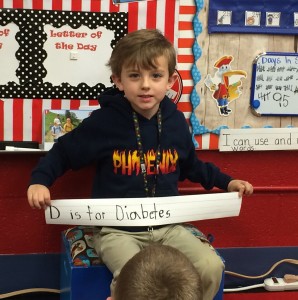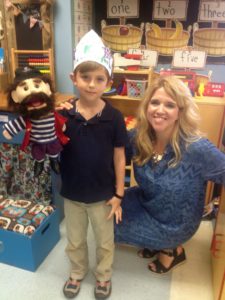Sally’s Note:
Ms. Hill was Hugh’s kindergarten teacher who literally saved me from drowning in all my worries and fears his first year in public school. She was more than a teacher, she became a dear friend – as have subsequent teachers who have taught Hugh. Teachers have a hard job, and adding a child with special needs makes it so much harder. But all of Hugh’s teachers have been up for the challenge and have worked with us in every possible way. There’s a lot of give and take, a lot of calling and texting, a lot of reminders and notes, a lot of tears (ok, mainly on my part the first day of school when I have to drop Hugh off and he’s getting older and needing me less and what if his blood sugar drops and what if his blood sugar is high and well, you get the idea!) I asked Ms. Hill to write this for other teachers, but I also hope it helps parents of children of all abilities realize how hard their teachers work to get it right. There are no words to express my gratitude to all of Hugh’s teachers who went above and beyond their job description to do just that.
Teaching and Learning With a Type 1 Diabetic Student
They knew he was different, yet they knew he was the same. Hugh went to the office several times a day, but he did not look sick. He never ate that birthday cupcake like everyone else (always icing first), but he did take his cupcake home for later. He had cool stuff in his lunch box, but there was always a special piece of paper with some numbers on it. You wouldn’t see an oatmeal cream pie in that lunch box, but sometimes there was a Hershey’s kiss. Hugh ran just as fast as the others in his kindergarten class. He was one of the first to begin reading. Hugh was a great artist and story teller. He could do everything a strong kindergartener could do and then some, but Hugh has Type 1 Diabetes.
When I was informed during the summer that I would have a diabetic student on my roster, it of course sent a fear through me. What if I did something wrong? I am not a nurse. I am only qualified to apply cute band aids and boo-boo bunnies, to check warm foreheads with the back of my hand, and be intuitive about that kid that looks a bit green in the lunchroom. My first thought was, “I am going to screw this up”! Sixteen years had gone by, without having a student with serious medical conditions, but it didn’t take long for me to realize something. God would give me the tools I needed to be the teacher and care giver that Hugh needed. I had a lot to learn about Diabetic kids. I started by doing some online research. I thought about how this special child would want to be treated like everyone else, with empathy and not sympathy. I thought about his parents and how they would need some reassurance that I got this! I thought about how I could make a difficult situation be a learning experience of character and awareness for all the students in our class.
Are you going to be a teacher or a care giver of a student with Type 1 Diabetes? You can do it. Each child is different, but I’d like to share a few things that made our school year together a successful one.
- Meet with your student and their family before school starts somewhere casual. Hugh’s mom and I scheduled a meeting at Chick Fil A. We had lemonade and talked as Hugh and his sister played. Meeting before school in a casual atmosphere put us all at ease and it helped me connect with this precious family.
- Get all the school faculty “in the know”. Hugh’s mom sent several important things that gave our entire faculty some piece of mind. She sent documents with Hugh’s picture, condition, and emergency directions. I put it in my substitute binder in case I was out of the classroom. We had them in the office as well. Hugh had about 5 other teachers, such as P.E. and enrichment classes. We all received an emergency snack pack in case his blood sugar dropped. The first few weeks of school, I made sure his art, music, computer, library, and P.E. teachers knew just who Hugh was and reminded them of his condition. During the school year, if any of his enrichment teachers had a substitute, I would discretely ask them not to dismiss any complaint Hugh might have and to always send him to the office with a buddy if he had a complaint.
- Give a diabetic student your full attention If you’re a teacher, you know kids will come to you 100 times a day and only about 1 or 2 of those times is even necessary. We make split second decisions on what we should pay attention to and what to brush off. With Hugh, I was lucky; he was not a needy child. He was very independent and didn’t need me to fix things for him often. So when Hugh came to me, I always stopped what I was doing and looked him in the eye to assess his situation. Teachers have a mother instinct. These instincts often directed me in the decisions I made in his daily routines. If I was ever in question about something he should eat, how his face looked a bit paler than normal, a nervous look in his eye, or a sign of lethargy, I would call mom or our amazing school secretary.
- I can’t stress enough how important the school secretary is if your school doesn’t have a full time nurse. Make sure you work well with her and that you are on the same page. The more people being aware and trained with a diabetic student, the better.
- Make them fit in and not stand out. It was important to me to make Hugh feel he was as normal as everyone, so I tried to always stay calm and reassuring. I never called him out about his condition and tried to handle all matters discreetly. However, I let him own it. When we had our weekly letter of Dd, I used that opportunity to let Hugh teach his classmates what Diabetes was all about. Dd is for Diabetes. He did great! The kids asked him questions like, “Do the shots hurt?”, “Does diabetes go away?”, “Can I catch it?” and the hard one, “Why did you get Diabetes?” Hugh answered all their questions better than I could have. After that day, his classmates were like oh, okay, and it was business as usual. But this was empowering for Hugh. He could handle this condition he had and he could help his friends be aware of this disease. His friends that would be with him for years to come will continue to be by his side, aware and not scared of it all.
- Keep an open door. Anytime Hugh’s parents or grandparents wanted to come in, they were welcome, and often they did. This turned out to be the biggest blessing for me as a teacher. Once a week, Hugh’s grandmother came at lunch and hung out with us in the classroom for a couple of hours. She read with some, helped with puzzles and crafts, and all the while she was able to take the pulse of Hugh’s environment. This gave all of us such a feeling of comfort. If you are a teacher that feels strange about parents being in your room because they are critiquing you, please don’t. Do what you always do, and they will trust you. You will be so grateful for that extra set of caring hands. At the end of the year, I came to the realization that having a child with special needs doesn’t have to be an inconvenience or a cloud always looming overhead. Having a student with Type 1 Diabetes made me the student and Hugh was so often the teacher. I think I received more from this child and his family than I could ever give them. So, have no fear, this can be a great year!
Esther Hill
Kindergarten Teacher @ Phoenix Magnet Elementary

